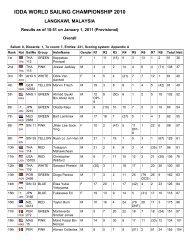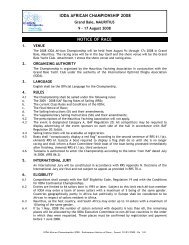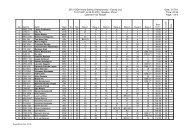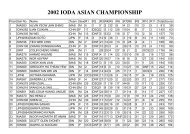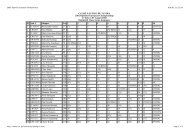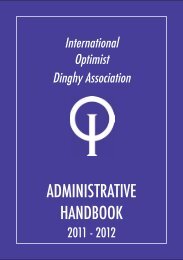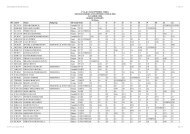2011 INTERNATIONAL OPTIMIST CLASS RULES
2011 INTERNATIONAL OPTIMIST CLASS RULES
2011 INTERNATIONAL OPTIMIST CLASS RULES
You also want an ePaper? Increase the reach of your titles
YUMPU automatically turns print PDFs into web optimized ePapers that Google loves.
ten pocket.<br />
b. The intersection of the leech and the lower edge of the top batten pocket on the<br />
intersection of the leech and the upper edge of the lower batten pocket.<br />
c. The clew point and intersection of the leech and the lower edge of the lower batten<br />
pocket.<br />
Sails which do not comply with CR 6.3.3.4 shall not be used after 1 March 2005.<br />
6.3.3.5 The leech shall not deviate more than +20/-5 mm from a straight line between the intersection<br />
of the leech and the lower edge of the top batten pocket and the clew point. Sails<br />
presented for first measurement after 1 March 2005 shall comply with this rule.<br />
6.3.3.6 The following are permitted: stitching, glues, bolt ropes, tabling, 2 batten pockets, batten<br />
pocket elastic, batten pocket patches, flutter patches, one trapezoidal window, sail<br />
maker label, sail button(s), tell tales.<br />
Primary reinforcements shall be made of woven ply of any thickness. The ply fibres shall<br />
be made of polyester or cotton. Secondary reinforcements shall be made from the same<br />
woven ply as the body of the sail, with the exception that batten pocket patches and flutter<br />
patches may be made from a woven cotton or polyester ply, thinner than that of the<br />
body of the sail. Edges of secondary reinforcements shall be fixed by a maximum of two<br />
lines of stitches or bonding agents. Parallel or nearly parallel lines of stitching or bonding<br />
agent used elsewhere in the secondary reinforcement shall be more than 40 mm<br />
apart. If two rows of closely positioned stitching are used to fix the edge of the secondary<br />
reinforcement then any inner lines of parallel stitching shall be more than 40 mm distant<br />
from the inner line of edge stitching. Tabling shall be either by folds of the body of the<br />
sail or of separate polyester or cotton material not thinner than the body of the sail.<br />
Further to CR 1.2 and 6.1.2, the following are prohibited: carbon fibres, titanium.<br />
6.3.3.7 Wire or elastic cord shall not be used in the sail. Any bolt rope or tabling used to strengthen<br />
the luff or head of the sail shall be fastened to the sail throughout its entire length. If<br />
a bolt rope is enclosed in the tabling, it shall be sewn to the sail by visible stitches at<br />
those corners of the sail to which the rope extends. No bolt rope is permitted in the leech<br />
or foot.<br />
6.3.3.8 There shall be 8 eyelets in the foot of the sail, including those at the tack and clew.<br />
There shall be 8 eyelets in the luff of the sail, including those at the throat and tack. (See<br />
also CR 6.4 for spacing between eyelets in luff and foot.)<br />
6.4 Dimensions<br />
Minimum Maximum<br />
1 Leech length - 2800 mm<br />
2 Head length - 1240 mm<br />
3 Diagonal 2450 mm 2580 mm<br />
4 Half width - 1700 mm<br />
5 Foot median - 2130 mm<br />
6 Luff length - 1730 mm<br />
7 Width of luff measurement band 5 mm -<br />
8 Length of luff measurement band 60 mm -<br />
9 Upper edge of luff measurement band to<br />
throat point - 600 mm<br />
10 Thickness of woven ply anywhere in the<br />
body of the sail 0.15 mm -<br />
11 Primary reinforcements:<br />
from corner measurement points - 205 mm<br />
24



